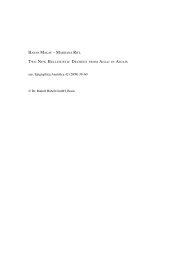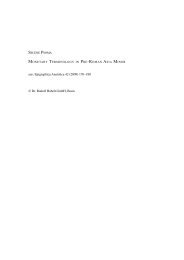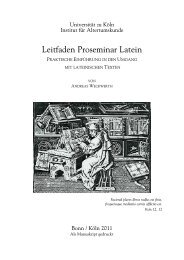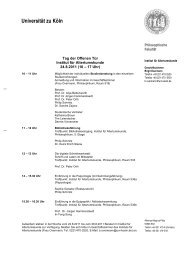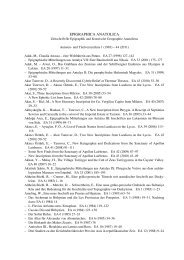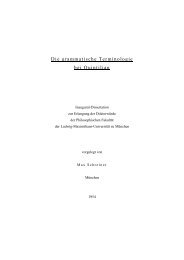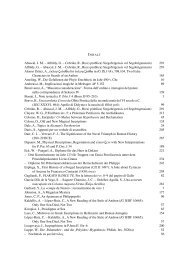ZPE Inhalt Bände 101ff. - Institut für Altertumskunde - Universität zu ...
ZPE Inhalt Bände 101ff. - Institut für Altertumskunde - Universität zu ...
ZPE Inhalt Bände 101ff. - Institut für Altertumskunde - Universität zu ...
You also want an ePaper? Increase the reach of your titles
YUMPU automatically turns print PDFs into web optimized ePapers that Google loves.
56 Autoren- und Titelverzeichnis <strong>ZPE</strong> 101 ff.<br />
–, A Fragment of the Life of Moses of Abydos in the British Library. 179 (2011) 117–122<br />
ULLMANN, L., Two Ostraca with the Niceno-Constantinopolitan Creed in the Israel Museum. 113 (1996) 191–196<br />
URANO, S., Kolletiones and frumentarii: New Readings of TAM 3, 1417–1418. Two Petitionary Inscriptions from Ağabey Köy and Mendechora. 176<br />
(2011) 179–188<br />
VACANTE, S., Un frammento di stele monumentale da Mitilene (IG XII 2, 8): confronti e ipotesi di datazione. 174 (2010) 85–88<br />
VAGENHEIM, G. – CUVIGNY, H., Un «faux» sur porphyre: avatars et aventures de la stèle de Théra honorant le gymnasiarque Batôn (IG XII 3, 331,<br />
153 av. J.-C.). 151 (2005) 105–126<br />
VALENTE, St., Sul significato di glvsshmatik«w in Timeo Sofista. 170 (2009) 65–72<br />
–, A Greek–Latin Fragment of the ‘erweiterte Synagoge’ in ms. Arund. 9 F. 55 r . 181 (2012) 54–60<br />
VALERIO, F., Ancora su Bacch. 5.151. 175 (2010) 3–4<br />
–, Nota testuale su un’iscrizione tardo-antica da Gerasa (SGO 21/23/03). 179 (2011) 116<br />
VALLARINO, G., Epigramma dedicatorio per uno hyparchos dall’area del Pretorio di Gortina. 183 (2012) 59–66<br />
VANDORPE, K., A Greek Register from Pathyris’ Notarial Office. Loans and Sales from the Pathyrite and Latopolite Nomes. 150 (2004) 161–186<br />
VAN HAEPEREN, F., Réflexions sur les dendrophores de Pouzzoles, à partir de CIL X 3699. 172 (2010) 259–266<br />
VAN ’T WOUT, P. E., Neglected Evidence for the Nature of ἀτιµία. Agora P 17615 and DTA 107. 176 (2011) 126–134<br />
VARDI, A., Gellius Against the Professors. 137 (2001) 41–54<br />
VEEN, CH. – ECK, W., Epigraphische Bronzefragmente aus Nijmegen. 175 (2010) 241–246<br />
VEKSINA, M., Zur Datierung der neuen Weihinschrift aus dem Oxos-Tempel. 181 (2012) 108–116<br />
VELAZA, J., Iberisch eban, teban. 104 (1994) 142–150<br />
–, Dos nuevas aras votivas procedentes de Muzqui (Navarra). 181 (2012) 260–262<br />
VELAZA, J. – MEZQUÍRIZ, M. A., Un anillo infantil con inscripción griega procedente de Andelo (Muruzábal de Andión, Navarra). 152 (2005) 171–<br />
172<br />
VELAZA, J. – RIPOLLÈS, P. P., Saguntum, colonia Latina. 141 (2002) 285–291<br />
VELÁZQUEZ, I. – CURBERA, J. B. – SIERRA DELAGE, M., A Bilingual Curse Tablet from Barchín del Hoyo (Cuenca, Spain). 125 (1999) 279–283<br />
VENDRUSCOLO, F., Pindaro, Threnoi fr. 129,10–11 Snell–Maehler. 101 (1994) 16–18<br />
VENTURA VILLANUEVA, Á., Fasti Duovirales Coloniae Augustae Emeritae: Reflexiones sobre la concepción, gestación y nacimiento de la ciudad de<br />
Mérida. 170 (2009) 215–246<br />
VERDAN, S. – KENZELMANN PFYFFER, A. – THEURILLAT, Th., Graffiti d’époque géométrique provenant du sanctuaire d’Apollon Daphnéphoros à<br />
Erétrie. 151 (2005) 51–83<br />
VERDEJO MANCHADO, J. – ANTELA-BERNÁRDEZ, B., IG II 2 1334: A Crown for Onaso and the Archon Athenion. 177 (2011) 91–96<br />
VERGADOS, A., Hesiod, Hellanikos und Hermes (<strong>zu</strong> <strong>ZPE</strong> 160, 2007, 15–23). 175 (2010) 20–21<br />
di VEROLI, P., Nuovi eponimi della Sicilia ellenistica. 110 (1996) 309–310<br />
VERRETH, H., A Coastal Road in the Northern Sinai in P. Oxy. XLII 3011? 126 (1999) 223–224<br />
–, Kasion, Kasiotes and Kasiotikos. 158 (2006) 235–239<br />
VERRETH, H. – GOLDFUS, H., A Greek Magical(?) Ostrakon from Elousa (Haluza). 128 (1999) 150–152<br />
VERVAET, F. J. – DART, C. J., The Significance of the Naval Triumph in Roman History (260–29 BCE). 176 (2011) 267–280<br />
VIAN, F., L’histoire d’Astérios le Crétois: Nonnos tributaire des Bassariques de Dionysios? 122 (1998) 71–78<br />
VINCI, M., Un nuovo epitaffio in greco della Sicilia di età alto-imperiale e il formulario con gli epiteti xrhstÚw ka‹ êmemptow. 162 (2007) 188–192<br />
VINE, B., Remarks on the Archaic Latin “Garigliano Bowl” Inscription. 121 (1998) 257–262<br />
VINOGRADOV, J., Ein sprechender Lagynos aus Olbia Pontica. 121 (1998) 149–152<br />
VINOGRADOV, J. – RUSJAEVA, A. S., Phantasmomagica Olbiopolitana. 121 (1998) 153–164<br />
VINSON, S., PaktoËn and pãktvsiw as Ship-Construction Terminology in Herodotus, Pollux and Documentary Papyri. 113 (1996) 197–204<br />
–, P. Grenf. II, 23: A New Edition. 121 (1998) 197–202<br />
VLASSOPOULOS, K., Athenian Slave Names and Athenian Social History. 175 (2010) 113–144<br />
van der VLIET, J., Cologne Coptic Magical Texts: Some Notes and Corrections. 122 (1998) 119–122<br />
–, A Coptic Charitesion (P. Gieben Copt. 1). 153 (2005) 131–140<br />
–, Parerga: Notes on Christian Inscriptions from Egypt and Nubia. 164 (2008) 153–158<br />
van der VLIET, J. – ŁAJTAR, A., Rome – Meroe – Berlin. The Southernmost Latin Inscription Rediscovered (CIL III 83). 157 (2006) 193–198<br />
VOCKE, H., Papyrus Magdalen 17 – weitere Argumente gegen die Frühdatierung des angeblichen Jesus-Papyrus. 113 (1996) 153–157<br />
VOIŞIAN, V. – CIONGRADI, C. – BOTA, E., Eine Konstitution <strong>für</strong> die Hilfstruppen von Dacia Porolissensis aus dem Jahr 128 n. Chr. 170 (2009) 207–<br />
214<br />
VOLOKHINE, Y. – SÁNCHEZ, P. – SCHUBERT, P., Une dédicace grecque de l’époque impériale tardive trouvée à Hermonthis (Ermant, Haute-<br />
Égypte). 174 (2010) 127–132<br />
VÖSSING, K., Schreiben lernen, ohne lesen <strong>zu</strong> können? Zur Methode des antiken Elementarunterrichts. 123 (1998) 121–125<br />
–, CIL IV 7698 und die Bedeutung von mappa (Varro ling. 9,47 und Hor. epist. 1,5,22). 137 (2001) 35–40<br />
–, Vor dem Nachtisch oder nach Tisch? Zum Opfer beim römischen Bankett. 146 (2004) 53–59<br />
VOUTIRAS, E., Wortkarge Söldner? Ein Interpretationsvorschlag <strong>zu</strong>m neuen Poseidippos. 104 (1994) 27–31<br />
WACHTEL, K., ∏ 64/67 : Fragmente des Matthäusevangeliums aus dem 1. Jahrhundert? 107 (1995) 73– 80<br />
WACHTEL, K. – ECK, W., Die Prosopographia Imperii Romani im Internet. 125 (1999) 232<br />
WACHTER, R., „Oral Poetry“ in ungewohntem Kontext: Hinweise auf mündliche Dichtungstechnik in den pompejanischen Wandinschriften. 121<br />
(1998) 73–89<br />
–, Ein schwieriges rhodisches Graffito. 121 (1998) 90–93<br />
–, êWanaj im Sinne von ênarxow? Ein möglicher Hinweis auf das Fortleben des mykenischen Herrschertitels auf der Peloponnes. 130 (2000) 1–7<br />
–, Ariston weihte drei Töchter. 142 (2003) 53–63<br />
–, BA - BE - BH - BI - BO - BU - BV . . . Zur Geschichte des elementaren Schreibunterrichts bei den Griechen, Etruskern und Venetern. 146 (2004) 61–74<br />
–, Annex <strong>zu</strong> Fragment 3 der Graffiti von Eretria. 151 (2005) 84–86<br />
WACHTER, R. – CORFÙ, N., Eine böotische Scherbe mit Graffito. 179 (2011) 141–144<br />
WAEBENS, S., Reflecting the “Change in A.D. 140”: The Veteran Categories of the epikrisis Documents Revisited. 180 (2012) 267–277<br />
WAGEMAKERS, B. – AMELING, W., A New Photograph and Reconsidered Reading of the Lost Inscription from Khirbet el-Khalidi (IGLSyr XXI 4,<br />
137). 183 (2012) 176–178.<br />
WAGMAN, R., Restorations on the Epidaurian Hymns. 103 (1994) 101–102<br />
–, Un devoto del dio Sole ad Epidauro. 103 (1994) 103–105







